Learn About Electric Fish
Species diversity in EODs
Pulse-type vs. Wave-type EODs
Weakly electric fish produce one of two types of EODs: wave-type EODs and pulse-type EODs. For species that produce wave-type EODs, the duration of each discharge is approximately equal to the time between discharges, and the timing between discharges is relatively constant. Durations of pulse-type EODs are much shorter than the time between discharges. Species that emit pulse-type EODs often vary the timing between discharges.
The tiger knifefish, Rhamphichthys marmoratus, produces a pulse-type EOD. The graph below shows the voltage difference between the head and the tail of the fish as a function of time. Each spike on the graph is an individual EOD pulse. Notice how the duration of each "pulse" of the EOD is much shorter than the time between pulses. Click on the player below to hear what the discharge of R. rostratus sounds like when amplified and played through a speaker.
 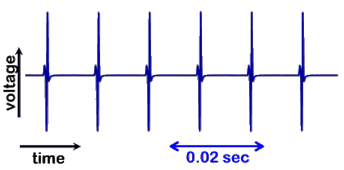 |
| EOD trace (head-tail voltage vs. time) of Rhamphichthys marmoratus. |
The gold-lined black knifefish, Sternopygus macrurus, produces a wave-type EOD. In the graph below, notice how the duration of each discharge is about the same as the time between each discharge. Notice how this "wave-type" EOD sounds more "tonal" than the pulse-type EOD of Rhamphichthys.
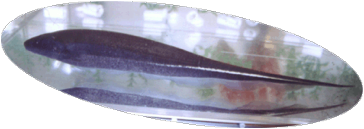 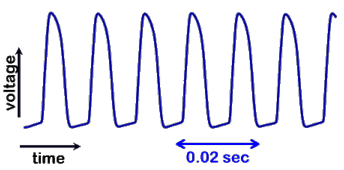 |
| EOD trace (head-tail voltage vs. time) of a male Sternopygus macrurus. |
EOD frequency differences among species that produce wave-type EODs
EOD frequency varies widely among different species of weakly electric fish. For example, Sternopygus macrurus has EOD frequencies of ~50-200 Hz. The EOD in the figure above is from a male S. macrurus and has a frequency of 86 Hz. (Click on the players below to hear examples of the EODs of different species.)
The transparent knifefish Eigenmannia virescens, shown below, has an intermediate EOD frequency (250-500 Hz).
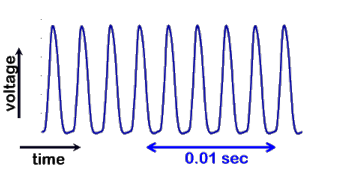  |
| Eigenmannia virescens (right) and the EOD voltage trace of a female E. virescens (left). The frequency of this EOD is 448 Hz.
|
Apteronotid electric fish, like the marble leaf knifefish Adontosternarchus devenanzii, have high frequency EODs (500-2000 Hz). Apteronotid EODs are one of the fastest and most precise biological oscillations known. Notice how the waveform of each discharge also differs between species.
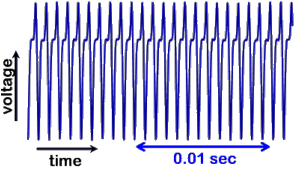  |
| Adontosternarchus devenanzii and its EOD. The frequency of this EOD is 1240 Hz.
|
Because EOD frequency and waveform vary across species, they can be used as a signal of species identity. A major focus of our research is understanding the evolution of species diversity in EOD frequency and its function as a communication signal.
